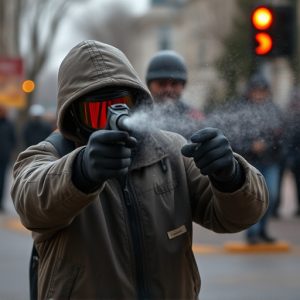Deciphering the Impact and Chemistry of Tear Gas on Vision: A Safety and Ethics Guide
Tear gas, a chemical agent for crowd control, contains compounds like oleoresin capsaicin, similar …….
Tear gas, a chemical agent for crowd control, contains compounds like oleoresin capsaicin, similar to pepper spray. Exposure causes intense visual and health impacts, including temporary blindness from involuntary eye closure due to pain, which can last up to half an hour or longer. The severity of effects varies with concentration, exposure time, and individual tolerance. While rare, prolonged exposure might lead to permanent damage, but a single encounter typically does not result in lasting blindness. Victims experience severe discomfort and acute pain. It's important to exit the area immediately, shield the eyes, and seek medical care if necessary. Understanding tear gas's effects is vital for safety and informed decision-making. Pepper spray, a component of some tear gas formulations, can cause temporary blindness through severe irritation of mucous membranes. Its use is regulated due to potential health consequences and must be employed within legal and ethical guidelines that ensure it is necessary, proportionate, and non-discriminatory. The question of whether pepper spray can blind you is addressed by recognizing the rarity of permanent blindness from typical exposure, with effects generally being temporary. Legal constraints and ethical considerations must guide the use of tear gas in crowd control to prevent serious injury and uphold human rights.
Tear gas, a controversial tool used in crowd control and self-defense, remains a topic of intense debate. Its potent effects on the eyes raise questions about its impact on vision, with concerns ranging from temporary discomfort to the misconception that it can cause permanent blindness. This article delves into the chemistry behind tear gas agents, their deployment methods, and the resulting physiological responses they provoke. It also compares tear gas to other non-lethal irritants like pepper spray, addressing whether pepper spray can blind you under certain conditions. Beyond the physical aspects, this piece examines the legal and ethical frameworks governing the use of tear gas, highlighting the complex implications and regulations that shape its deployment in various contexts. Understanding these elements is crucial for informed discussions on the role of tear gas in modern law enforcement and personal safety measures.
Understanding Tear Gas and Its Impact on Vision: Can Pepper Spray Cause Blindness?
Tear gas, a chemical agent used for crowd control and riot management, can have profound effects on individuals’ vision and overall well-being. The compounds found in tear gas, such as oleoresin capsaicin—commonly known as pepper spray—stimulate pain receptors in the eyes and mucous membranes upon contact. When this substance comes into contact with the eyes, it induces an intense burning sensation that can lead to temporary blindness. The severity of the impact on vision varies depending on factors like concentration, exposure time, and individual sensitivity. While permanent blindness from a single exposure is rare, the intensity of the irritation can cause the eyes to close reflexively, effectively rendering the victim temporarily unable to see. The effects are not limited to blindness; they also include severe discomfort, difficulty in opening the eyelids, and extreme pain, which can last for up to 30 minutes or more after exposure. It is crucial for those affected by tear gas to remove themselves from the affected area, protect their eyes, and seek medical attention if necessary. Understanding the capabilities and limitations of tear gas, particularly in terms of its impact on vision, is essential for both law enforcement and individuals who may encounter such agents in various situations.
The Chemistry of Tear Gas: Composition, Deployment, and Effects
Tear gas, a non-lethal chemical agent used to disperse crowds and control confrontational situations, is formulated from a variety of irritant compounds. The most common types include chloracetophenone, CS (ortho-chlorobenzylmalonitrile), CN (composition C tear gas), and OC (oleoresin capsicum, also known as pepper spray). These agents induce a strong irritant response when introduced to the human body, particularly the mucous membranes. Upon deployment, the effects are almost instantaneous, causing a stinging sensation in the eyes, nose, throat, and lungs, which can lead to tears, coughing, and short-term blindness. The intensity of the effects is influenced by factors such as wind direction, concentration of the agent, environmental conditions, and individual sensitivity. It’s often asked whether pepper spray can permanently blind you; while temporary blindness can occur due to the severe irritation causing closure of the eyelids, permanent blindness from exposure to pepper spray is highly unlikely under typical use conditions.
The chemistry of tear gas is complex, as it involves organic compounds that interact with sensory receptors in the body. These agents work by stimulating the TRPA1 ion channel in sensory neurons, which activates a pain response and the reflex to evacuate the affected area. The composition of tear gas cannisters is tightly regulated due to its potential for misuse. Deployment methods range from handheld devices to large-scale canisters launched by military or law enforcement. The effects of tear gas exposure are not only physical but also psychological, as the intense discomfort can create a state of panic and disorientation among those affected. Understanding the chemistry and effects of tear gas is crucial for its proper use and for developing countermeasures to protect individuals from its harmful consequences.
Personal Defense Alternatives: A Comparison Between Pepper Spray and Other Non-Lethal Irritants
When considering personal defense alternatives, the efficacy and implications of using non-lethal irritants such as pepper spray are paramount. Pepper spray, commonly known as OC (oleoresin capsicum) spray, is a highly effective deterrent that can incapacitate an attacker by causing intense irritation to the eyes, skin, and respiratory system. The active ingredient in pepper spray, capsaicin, induces a burning sensation upon contact, potentially leading to temporary blindness if it enters the eyes. This response buys valuable time for escape or for law enforcement intervention. Unlike tear gas, which can affect a larger area, pepper spray offers a more focused application, allowing for precise targeting of an assailant while minimizing exposure to bystanders.
In comparison, other non-lethal irritants such as mace and riot control agents like CS or CN gases also have their place in personal defense and crowd control scenarios. These agents produce a strong irritating effect that can cause tears, coughing, and difficulty in breathing. However, unlike pepper spray’s effects which are reversible upon washing with water, the debilitating effects of tear gas can persist longer, potentially affecting the environment more broadly. The choice between these defense alternatives depends on various factors including legal restrictions, personal comfort with handling such substances, and the intended use case. It is crucial to understand the capabilities and limitations of each option, as well as their potential impact on both the attacker and any surrounding individuals, to make an informed decision that aligns with one’s personal defense strategy.
Legal and Ethical Considerations of Using Tear Gas in Crowd Control: Implications and Regulations
Tear gas, a chemical agent used to disperse and control crowds during civil unrest or protests, raises significant legal and ethical considerations. Legally, the use of tear gas is governed by international human rights laws, which dictate that law enforcement must comply with principles of necessity, proportionality, and discrimination—meaning force should only be used when strictly necessary to achieve a legitimate aim, and it should not be applied in an arbitrary or discriminatory manner. The deployment of tear gas, often in the form of canisters or grenades, has been a subject of debate, particularly concerning its impact on individuals’ rights to peaceful assembly and freedom from inhuman or degrading treatment.
Ethically, the use of tear gas necessitates careful scrutiny. While it is designed to temporarily incapacitate rather than cause lasting harm, questions arise regarding its long-term effects on health, including whether prolonged exposure can lead to permanent eye damage, as with the use of pepper spray. The potential for serious injury or even blindness from direct contact with tear gas cannot be overlooked, especially in situations where individuals may not have the means to protect their eyes. Moreover, the use of these agents in confined spaces, such as during protests within urban areas, raises concerns about the risk of asphyxiation and the collective punishment of crowd participants who may not engage in violent actions. Regulations vary by jurisdiction, with some regions imposing strict limitations on the deployment of tear gas, while others have more lenient policies. It is imperative that any use of these agents is underpinned by clear protocols and oversight to ensure compliance with both legal standards and ethical principles.


